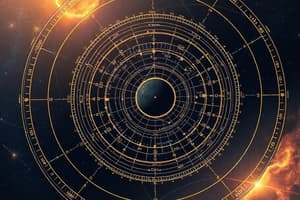Podcast
Questions and Answers
Who first proposed the heliocentric model of the universe?
Who first proposed the heliocentric model of the universe?
- Johannes Kepler
- Isaac Newton
- Ptolemy
- Nicholas Copernicus (correct)
What important discovery did Galileo Galilei make that supported the heliocentric model?
What important discovery did Galileo Galilei make that supported the heliocentric model?
- The Earth's orbit around the Sun
- The retrograde motion of Mars
- The existence of moons orbiting Jupiter (correct)
- The elliptical orbits of planets
How did Johannes Kepler modify the Copernican model?
How did Johannes Kepler modify the Copernican model?
- By adding epicycles to the planetary orbits
- By changing the position of the Sun in the model
- By introducing the concept of celestial spheres
- By placing the planets in elliptical orbits (correct)
What did Sir Isaac Newton's law of universal gravitation explain about planetary orbits?
What did Sir Isaac Newton's law of universal gravitation explain about planetary orbits?
What did Henrietta Leavitt and Edwin Hubble's work in the 20th century contribute to our understanding of the universe?
What did Henrietta Leavitt and Edwin Hubble's work in the 20th century contribute to our understanding of the universe?
What was the primary task of philosophy according to Plato and Aristotle?
What was the primary task of philosophy according to Plato and Aristotle?
According to Aristotle, how can one obtain knowledge of first principles?
According to Aristotle, how can one obtain knowledge of first principles?
What did the ancient Greeks believe about the movement of celestial bodies?
What did the ancient Greeks believe about the movement of celestial bodies?
What is a geocentric model of the universe?
What is a geocentric model of the universe?
When was the geocentric model of the universe first known to be postulated?
When was the geocentric model of the universe first known to be postulated?
Who explained celestial motion through uniform circular motion?
Who explained celestial motion through uniform circular motion?
What did Aristotle attribute the roundness of the Earth to?
What did Aristotle attribute the roundness of the Earth to?
Who modified the geocentric model to account for retrograde motion by adding epicycles to the planets' orbits?
Who modified the geocentric model to account for retrograde motion by adding epicycles to the planets' orbits?
What made it difficult for the Greeks to understand the true nature of the universe?
What made it difficult for the Greeks to understand the true nature of the universe?
Who adopted the geocentric model with the Earth as a stationary sphere?
Who adopted the geocentric model with the Earth as a stationary sphere?
Flashcards
Who was Copernicus?
Who was Copernicus?
First proposed the heliocentric model, placing the Sun at the center.
Galileo's Key Discovery
Galileo's Key Discovery
Observed moons orbiting Jupiter, supporting that not everything orbits Earth.
Kepler's Orbital Shape
Kepler's Orbital Shape
Modified the heliocentric model by using elliptical orbits instead of circles.
Newton's Universal Gravitation
Newton's Universal Gravitation
Signup and view all the flashcards
Leavitt & Hubble's Contribution
Leavitt & Hubble's Contribution
Signup and view all the flashcards
Plato & Aristotle's Philosophy Task
Plato & Aristotle's Philosophy Task
Signup and view all the flashcards
Aristotle's Path to 'First Principles'
Aristotle's Path to 'First Principles'
Signup and view all the flashcards
Ancient Greek Celestial Motion
Ancient Greek Celestial Motion
Signup and view all the flashcards
What is a geocentric model?
What is a geocentric model?
Signup and view all the flashcards
Geocentric Model Origin
Geocentric Model Origin
Signup and view all the flashcards
Eudoxus's Celestial Explanation
Eudoxus's Celestial Explanation
Signup and view all the flashcards
Aristotle and Earth's Shape
Aristotle and Earth's Shape
Signup and view all the flashcards
Ptolemy's Geocentric Modification
Ptolemy's Geocentric Modification
Signup and view all the flashcards
Greek Difficulty Understanding Universe
Greek Difficulty Understanding Universe
Signup and view all the flashcards
Plato's Geocentric View
Plato's Geocentric View
Signup and view all the flashcards
Study Notes
Ancient Greek Models of the Universe
- Anaximander imagined the Earth as a cylinder one-third as high as it is broad, fixed at the center of the universe, surrounded by fire, mist, and stars.
- The Greeks assumed the Earth was fixed in the universe due to the lack of stellar parallax, the change in apparent positions of objects against a backdrop.
- The Greeks lacked the technology to notice stellar parallaxes, which made it difficult to understand the true nature of the universe.
- Plato adopted the geocentric model with the Earth as a stationary sphere, surrounded by the Moon, Sun, and planets guided by the "Fates."
- Eudoxus explained celestial motion through uniform circular motion, while Aristotle described the heavenly bodies as attached to transparent spheres.
- Aristotle attributed the roundness of the Earth to the shadow it casts during lunar eclipses and observed phenomena like ship sails and the North Star.
- The Greek geocentric models could not account for retrograde motion, the apparent backward motion of planets in the sky.
- Claudius Ptolemy modified the geocentric model to account for retrograde motion by adding epicycles to the planets' orbits.
- Ptolemy's model was generally accepted despite challenges from Arabic astronomers due to its inability to explain the appearance of the Moon and planets' oscillations.
- It took another millennium and a half for retrograde motion to be explained accurately by Copernicus, Kepler, and Newton, by which time the heliocentric model was being adopted.
- The Ptolemaic model of the universe had the planets orbiting the Sun in circular orbits with epicycles.
- Ptolemy was a mathematician, astronomer, astrologer, and geographer who formulated a reasonably accurate system of predicting planetary positions.
Studying That Suits You
Use AI to generate personalized quizzes and flashcards to suit your learning preferences.




